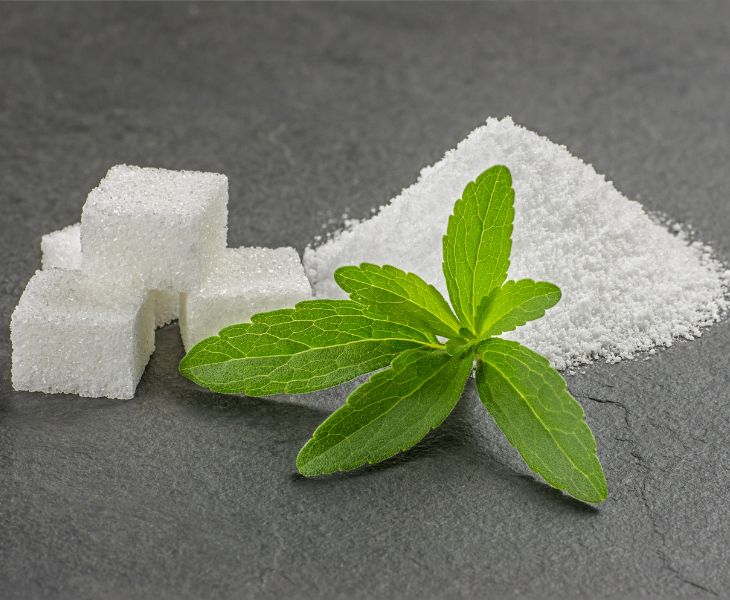Introduction: Are You Choosing the Right Sugar Substitute for Diabetes?
Did you know that some sugar substitutes can still raise blood sugar levels, while others have little to no impact? For individuals with diabetes, making the right choice is crucial to managing blood glucose levels effectively. With so many sweeteners available, it can be overwhelming to decide which ones are truly safe and healthy.
In this guide, we’ll explore the best sugar substitutes for diabetes, their benefits, potential risks, and how to use them effectively. Let’s dive in!
Table of Contents
Why Use Sugar Substitutes for Diabetes?
Swapping sugar for healthier alternatives is a smart move for people with diabetes. Refined sugar causes blood sugar spikes, leading to unstable glucose levels. However, sugar substitutes offer sweetness with minimal or no impact on blood sugar. Here’s why they’re beneficial:
- Lower Glycemic Index (GI) – Most sugar substitutes have a low or zero GI, preventing glucose spikes.
- Fewer Calories – Helps in weight management, which is essential for controlling diabetes.
- Improved Insulin Sensitivity – Some natural sweeteners may help improve insulin response.
Key Tip: Always check the glycemic index (GI) of sugar substitutes, as some marketed as “diabetic-friendly” may still have a moderate impact on blood sugar.
1. Stevia: The Natural Sweetener Powerhouse
What is Stevia?
Stevia is a plant-based sweetener derived from the Stevia rebaudiana plant. It contains steviol glycosides, which are 200-300 times sweeter than sugar but have zero calories and no impact on blood glucose levels.
Benefits of Stevia for Diabetes
- Zero Glycemic Impact: Does not raise blood sugar.
- Calorie-Free: Aids in weight management.
- Natural Origin: Free from artificial chemicals.
Potential Downsides
- Bitter aftertaste for some individuals.
- May cause digestive issues in large quantities.
How to Use Stevia
- Add a few drops to coffee or tea.
- Use powdered stevia in baking or cooking.
Best for: Beverages, smoothies, and light desserts.
Learn more about Stevia’s benefits
2. Monk Fruit: The Sweet Superfruit
What is Monk Fruit?
Monk fruit, also called Luo Han Guo, is a small green melon native to Southeast Asia. Its sweetness comes from mogrosides, which are calorie-free and have no effect on blood sugar levels.
Benefits of Monk Fruit for Diabetes
- Zero-Calorie Sweetener: Helps manage weight.
- No Impact on Blood Sugar: Safe for diabetics.
- Natural Antioxidants: Offers anti-inflammatory properties.
Potential Downsides
- May have a fruity aftertaste.
- Expensive compared to other sweeteners.
How to Use Monk Fruit
- Sweeten beverages or sauces with monk fruit extract.
- Use in baking by replacing sugar with monk fruit powder.
Best for: Drinks, baking, and sauces.
Read about monk fruit’s health benefits
3. Erythritol: The Low-Calorie Sugar Alcohol
What is Erythritol?
Erythritol is a sugar alcohol that occurs naturally in some fruits. It contains only 0.24 calories per gram (compared to sugar’s 4 calories) and has a glycemic index of zero.
Benefits of Erythritol for Diabetes
- No Blood Sugar Impact: Doesn’t raise glucose levels.
- Low-Calorie: Suitable for weight-conscious diabetics.
- Tooth-Friendly: Doesn’t promote tooth decay.
Potential Downsides
- May cause digestive issues in large amounts.
- Often blended with other sweeteners (check labels).
How to Use Erythritol
- Use in baking recipes as a sugar replacement.
- Add to coffee or tea for sweetness.
Best for: Baking, beverages, and desserts.
4. Allulose: The Rare Sugar with Big Benefits
What is Allulose?
Allulose is a low-calorie rare sugar found naturally in small amounts in wheat, figs, and raisins. It has 90% fewer calories than regular sugar and does not raise blood glucose levels.
Benefits of Allulose for Diabetes
- Low Glycemic Index: Minimal effect on blood sugar.
- Low-Calorie: Ideal for weight management.
- Sweet Taste: Tastes like regular sugar with no aftertaste.
Potential Downsides
- May cause bloating or diarrhea if consumed excessively.
- More expensive than traditional sugar.
How to Use Allulose
- Add to baked goods and sauces.
- Use in low-carb desserts.
Best for: Baking and dessert recipes.
Read about Allulose benefits
5. Coconut Sugar: A Natural Sweetener with a Lower GI
What is Coconut Sugar?
Coconut sugar is made from the sap of coconut palm trees. It contains small amounts of fiber and nutrients, making it a slightly healthier option than refined sugar.
Benefits of Coconut Sugar for Diabetes
- Lower GI (35) compared to white sugar (65).
- Contains Inulin: A fiber that slows glucose absorption.
- Rich in Antioxidants: Provides some nutritional benefits.
Potential Downsides
- Still contains fructose – may affect blood sugar if overused.
- High in calories compared to other substitutes.
How to Use Coconut Sugar
- Add to coffee or oatmeal for sweetness.
- Use in moderation when baking.
Best for: Occasional sweetening in cooking.
Learn more about Coconut Sugar
Sugar Substitutes to Avoid for Diabetes
Not all sugar substitutes are safe for diabetics. Avoid the following:
- Agave nectar – High in fructose, which raises blood sugar.
- Aspartame & Saccharin – Artificial sweeteners with potential health risks.
- High-fructose corn syrup (HFCS) – Linked to insulin resistance.
Comparison Table: Best Sugar Substitutes for Diabetes
| Sweetener | Glycemic Index | Calories | Best For |
|---|---|---|---|
| Stevia | 0 | 0 | Beverages, light foods |
| Monk Fruit | 0 | 0 | Drinks, desserts |
| Erythritol | 0 | 0.24 cal/gram | Baking, sweetening |
| Allulose | 0 | 0.4 cal/gram | Desserts, baking |
| Coconut Sugar | 35 | 15 cal/tsp | Occasional cooking |
Final Thoughts: Choose the Right Sugar Substitute for Diabetes
Choosing the best sugar substitutes for diabetes is key to keeping your blood sugar levels stable while enjoying sweet flavors. Stevia, monk fruit, erythritol, and allulose are excellent low-GI choices, while coconut sugar can be used sparingly. Always check food labels and consume in moderation.
Want more diabetic-friendly tips and recipes? Check out our 35 Diabetic-Friendly Delicious Recipes eBook for easy, blood-sugar-friendly meal ideas!
Share your favorite sugar substitute in the comments below!








